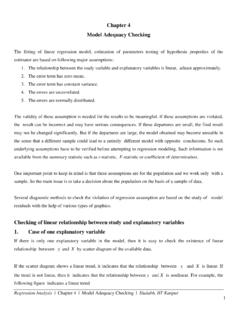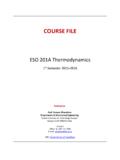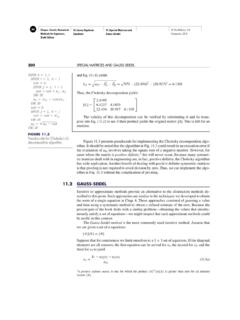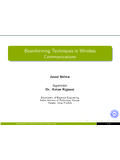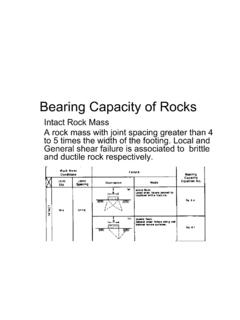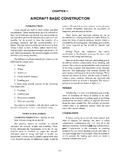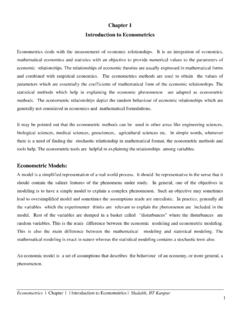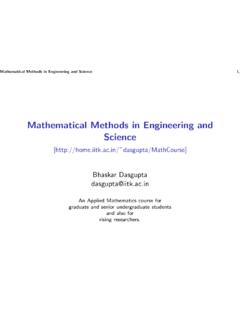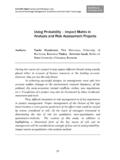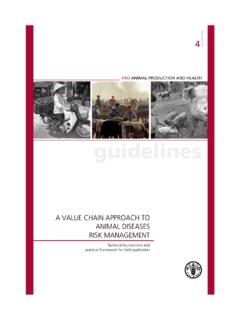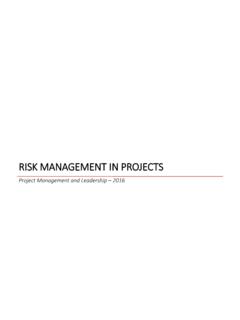Transcription of Article Documentary analysis as R a qualitative …
1 qualitative Research 1 17 The Author(s) 2015 Reprints and permissions: : RDocumentary analysis as a qualitative methodology to explore disaster mental health: insights from analysing a Documentary on communal riotsAswathy P ViswambharanIndian Institute of Technology Kanpur, IndiaKumar Ravi PriyaIndian Institute of Technology Kanpur, IndiaAbstractA paradigm shift in disaster mental health research has renewed the emphasis on the survivors experiences of suffering and healing. This Article highlights the importance of utilizing Documentary analysis as one of the important qualitative methodologies to explore post-disaster distress of the survivors. Following Figueroa s (2008) approach to the analysis of audio-visual texts, the methodological steps, outcomes and their salience have been illustrated through an analysis of a Documentary produced by Rakesh Sharma titled Final Solution, based on post-Godhra riots in 2002 in India.
2 The two-phased analysis involved constructionist grounded theory procedures with an initial focus on the Documentary as a whole . The methodological steps, rigour and the resulting categories of survivors suffering ( overwhelmed by losses , relational disruption , living a forced identity and denial of justice and equity ) are discussed in the light of the damage a disaster causes to survivors experiences of self and social theory, trauma, violence, visual methodsCorresponding author:Kumar Ravi Priya, Department of Humanities and Social Sciences, Indian Institute of Technology Kanpur, Uttar Pradesh-208016, India. Email: ResearchViswambharan and Priyaresearch-article2015 Article at INDIAN INST TECH KANPUR on February 10, from 2 qualitative Research Disaster mental health.
3 Traditional and new paradigmsThe United Nations International Strategy for Disaster Reduction (UNISDR) has defined disaster as a serious disruption of the functioning of a community or a society involving widespread human, material, economic or environmental losses and impacts, which exceeds the ability of the affected community or society to cope using its own resources (UNISDR, 2007: ). As loss of lives and property or drastic negative changes in the social order and human relationships may exceed human ability and resources to address the distress, disasters give rise to substantial risk to mental and social wellbeing of survi-vors (Coppola, 2007). Posttraumatic stress disorder (PTSD), with its major symptoms of intrusive recollection of traumatic events, avoidance of any stimulus associated with the event, negative alternations in cognition and emotions, and heightened arousal or hyper-vigilance, has been used as a predominant diagnostic category in disaster mental health research within the traditional positivist paradigm to map the distress related to disaster (American Psychiatric Association, 2013).
4 However, in recent decades, it has been chal-lenged for the claims of universality and objectivity associated with it (Breslau, 2004; Summerfield, 1999; Young, 1995). Lewis-Fernandez and Kleinman (1994) point out that the diagnostic categories (including PTSD) used in psychiatry are based on the following assumptions about mental illness: (a) the egocentricity of self (the psychological normal-ity and abnormality are internal to one s own self), (b) mind body dualism (events arise separately either in brain or in mind and there is no interaction between the two) and (c) culture as an epiphenomenon to the observed biological reality. They also contended that these assumptions may not be relevant in the study of mental illness or suffering in socie-ties that uphold a socio-centric worldview (where seeking harmony within relationship, rather than having a sense of individual autonomy, agency and control, is the key feature of self-growth or wellbeing).
5 Weiss et al. (2003), in a qualitative study, explored the views of leading researchers of disaster mental health about mental health outcomes of survivors and policies related to post-disaster care. Their study showed that rather than having unanimity over PTSD as a universal outcome of disasters, some of the respondents considered PTSD as not always being meaningful and useful in all the socio-cultural settings; especially where autonomy and agency are not taken to be important notions of selfhood. Similarly, as per Bracken et al. (1995), Breslau (2004), Summerfield (1999) and Young (1995), the concept of traumatic memory or the memory that carries with it the trauma of past to erupt into the symptoms of PTSD (especially, intrusion-avoidance), is based on the notions of self assumed to be constituted through continuities of memory that may not be a shared meaning of self across cultures of the world (Breslau, 2004: 116).
6 A shift can be noticed in the contemporary disaster mental health research as it involves an interdisciplinary approach that takes into account the cultural and contex-tual processes shaping survivors experiences (Bracken et al., 1995; Pedersen, 2002; Priya, 2010, 2012b; Summerfield, 1999). Kleinman (1987: 452) emphasized such an interdisciplinary approach to avoid category fallacy , that is the reification of a nosological category developed for a particular cultural group that is then applied to members of another culture for whom it lacks coherence and its validity has not been established . at INDIAN INST TECH KANPUR on February 10, from Viswambharan and Priya 3 This Article contributes to the use of interdisciplinary perspectives within disaster mental health research by proposing and illustrating the use of one of the innovative methods relevant for the study of survivors subjective experiences of intense distress within their socio-historical context.
7 It outlines the basic premises and procedures involved in Documentary analysis (or the analysis of audio-visual material or data using an audio-visual data as an object of analysis or AVO-approach1 as given by Figueroa, 2008), and then illustrates its usefulness for the study of the experiences of post-disaster distress within its context. For this purpose, Final Solution, a Documentary based on the interviews with and observations within the socio-political settings of the survivors of post-Godhra riots in India, has been analysed and the findings are presented. Finally, the suitability of Documentary analysis within an interdisciplinary perspective on disaster mental health research is discussed.
8 But, first let us take a look at the theoretical and methodological changes within the disaster mental health research to which documen-tary analysis has a potential to and methodological shiftsBesides the loss of lives and property, post-disaster distress may also be caused by a damage to social worlds (comprising family and community relationships and cultural meanings of self that pivotally shape one s sense of selfhood) including the aggravation of the process of social exclusion faced by survivors (Summerfield, 1999; Pedersen, 2002). The concept of suffering (or social suffering ) has often been used to under-stand such an intense distress. Suffering is conceptualized as the intense distress experi-enced by a person when the intactness of his or her selfhood (or personhood) is threatened as the social world shaping that selfhood is damaged (Cassell, 2004; Kleinman, 1988a; Kleinman et al.)
9 , 1998). For example, collective trauma, as observed by Abramowitz (2005) in some African countries facing ethnic conflicts, is the feeling of demoralization associated with non-adherence to the culturally valued notions of self defined by rela-tional harmony rather than selfish intentions or behaviour in the aftermath of the disaster by oneself or the community members. Similarly, survivors may also experience intense distress out of the destruction of the relational networks in the forms of prejudice, crea-tion or strengthening of social hierarchy and social exclusion. Priya (2007), in his ethno-graphic study among the survivors of an earthquake in India, observed their agony associated with being discriminated against by the villagers because of the emergence of a socio-economic hierarchy in the village caused by the loss of property and unregulated distribution of compensation money.
10 Acharya (2000) found among some female survi-vors of the Latur earthquake in India, an extreme distress associated with a denial of voice due to the gender norms through forced recanalization (a surgical operation that enables a woman, who was previously operated upon to nullify the chances of getting pregnant, to conceive a child once again), because they lost their sons in the earthquake and it was culturally desirable to have male child in the family. These examples indicate that besides the loss of family members:People can suffer from what they have lost of themselves in relation to the world of objects, events and relationships. Such suffering occurs because our intactness as persons, our coherence at INDIAN INST TECH KANPUR on February 10, from 4 qualitative Research and integrity, come not only from intactness of the body but also from the wholeness of the web of relationships with self and others.
